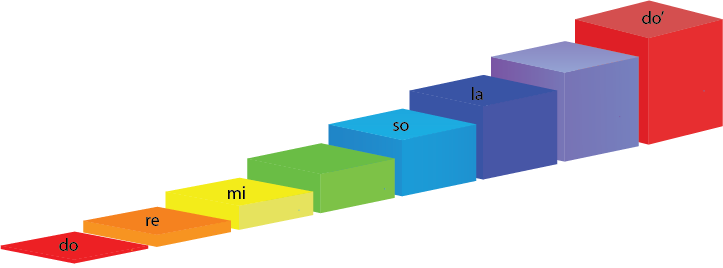Y3. Lesson 9. High do'
Prior learning: Major pentatonic
Duration: 30 minutes
Materials: Recorders
Keywords: Beat, rhythm, singing, chanting, partners, rhymes, circle games.
Difficulty: ![]()
Prepare
Present
High do'
Practise
The brass family.

The concept of high do' is important in music education, especially for teaching sight singing, ear training, and understanding musical structure. It helps students grasp the concepts of octaves, pitch relationships, and scale structure. By singing scales and melodies that span from do to high do', students develop a more intuitive sense of pitch and the layout of musical intervals.
In the movable-do system, do is the first degree of any scale. This means do can be any note, depending on the key of the music. This approach is particularly effective for teaching relative pitch and understanding musical relationships within a key.
 Melodic development
Melodic development
![]() Students discover a new note, high do'.
Students discover a new note, high do'.
- Project the staff on the board.
- Explain that there is a new note called high do', which has an apostrophe after the word.
- On the staff the new note is shown in red.
- Teach that If so is in a space, la is on the line above, and high do' is on the line above la.
- If so is on a line, la is in the space above, and high do' is in the space above la.
- Demonstrate high do' by singing it above the major pentatonic scale, ascending and pointing to each note of the scale on the staff.
- Ask students to repeat after you.
- When secure, demonstrate the descending scale, point and ask students to repeat.
- Students should copy both staffs in their notebooks, highlighting hi do'.
 Rhythmic development
Rhythmic development
![]() Students use body percussion to show the rhythm of a known classroom song.
Students use body percussion to show the rhythm of a known classroom song.
- Students are in a circle.
- Explain that the class will use body percussion and sing the song.
- First measure: Clap hands twice, then pat thighs twice.
- Second measure: Stomp right foot, then left foot.
- Third measure: Snap fingers right hand, then left hand.
- Fourth measure: Clap hands once, then slap sides (hands on hips).
- Repeat or change out the sequence for additional verses.
- Depending on the group's skill level, you can simplify the sequence by repeating easier patterns, adding complexity with faster sequences or incorporating more body sounds.
- Allow students to invent their own body percussion patterns for certain lines or verses to foster creativity and personal expression.
 Creative movement
Creative movement
![]() Students enjoy this classic circle game.
Students enjoy this classic circle game.
- Students are seated in a circle with their hands behind their backs.
- In this game, a chosen student carries a basket or other prop while walking around the other students as they sing together.
- Once the song finishes, that student gently places the prop behind a fellow student and dashes around the circle.
- The new student picks up the prop and chases after the first and tries their best to tag them.
- The pursuit concludes when the first student reaches the spot previously occupied by the second student.
 Listening
Listening
![]() Students identify four brass family instruments by listening.
Students identify four brass family instruments by listening.
- Remind students of the brass family and ask for their names, starting with the lowest sounding.
- Play each track on the audio player.
- Ask students to listen carefully as you play each one (repeat if necessary).
- Students should then name the brass instrument for each track.
 Visual learning
Visual learning
![]() Students discover how to identify and write high do'.
Students discover how to identify and write high do'.
- Project the scores on the board, or print out and distribute the worksheet.
- Explain that the note so is shown in each of the six examples.
- Ask students to point or write high do' for each example.

 Instruments
Instruments
![]() Students continue their journey on the recorder with a traditional BAG song.
Students continue their journey on the recorder with a traditional BAG song.
- Students will use their prior learning of the notes BAG in this traditional song.
- Ensure students are holding the instrument correctly and use gentle tonguing using "too".
- Students should count 1,2,3,4 in their heads as they play and take a breath where marked by a comma.
- In the last measure, there is a crotchet rest, which lasts for two beats. If students have not seen this symbol before, then explain its time value.
- As this song is the longest yet seen, establishing competency may take more than one learning period.
 Part work
Part work
![]() Students clap an ostinato pattern over a well-known classroom song.
Students clap an ostinato pattern over a well-known classroom song.
- Clap an ostinato pattern of your choice for use as an ostinato pattern for All Around The Buttercup. An example might be ti-ti, ta or ta, ti-ti.
- Lead the class in singing the song as you clap the ostinato.
- Students should follow your lead in singing and clapping.
- If time permits, then ask a volunteer to create another suitable pattern and repeat.
 Assess
Assess
Suggested lessons
Y1. Beat II

Y1. Beat III

Y1. Beat IV

